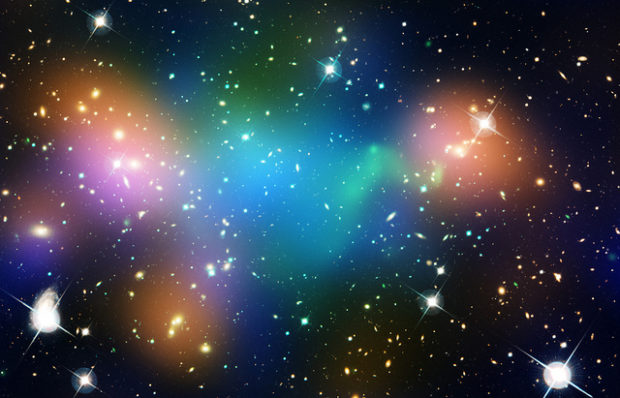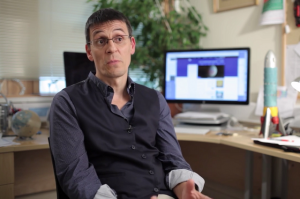The Impact of Higgs Boson Discovery
Physicist Jonathan Butterworth on the predictions of the Standard Model, new excitement about physics and futu...
The video is a part of the project British Scientists produced in collaboration between Serious Science and the British Council.
Astronomy is one of the oldest sciences, because everyone has looked up at the stars since the dawn of history. But the history of the science is that we gradually expanded our horizons. In the old days, people knew about the planets, but they thought the stars were in some sort of vault of heaven. Just a bit further away than the planets. It was gradually realized that the stars were much further away than the planets, because they were as bright as the Sun, but appeared so faint because of their great distances. And by the 19th century it was clear that most stars were like the Sun, and that the size of the universe that was visible then was many-many thousands of light-years. The next step forward was in the 1920s, when we realized that our Milky Way galaxy was a huge disk of stars in which the Sun was embedded. But it is just one of many. The Andromeda galaxy, which is about two million light-years away, is like our Milky Way: it is a spinning disk of gas viewed obliquely with lots of stars in it, and it is something which contains about a hundred billion stars. And in the 1920s and 30s it was realized that these galaxies, fully equal to our Milky Way, are the basic large-scale constituents of the universe. But the trouble was that the telescopes weren’t then powerful enough to be able to see the very distant ones. And the history of astronomy really ever since then has been the history of more and more powerful instruments enabling us to observe in greater detail and out to greater distances.
And this raises two questions: what’s happened in the remote past and what would happen in the remote future? In the remote past we would infer that everything was squeezed very close together and galaxies couldn’t exist in their present form. And, so, one of the aims of astronomy has been to understand the history of our universe in the past. And here we actually can do better than geologists can. Because geologists can just infer fossils of the past, whereas we can actually see the past. We can see the past because distant galaxies are so far away, that their light has taken long time to get to us. And so when we see a distant galaxy, we see it not as it is now, but as it was in the past. And by looking at galaxies one billion, two billion, three billion light-years away we can look back one billion, two billion, tree billion years into the past. And so we can learn something about what universe was like earlier on, when it was more compressed. And what we infer is that galaxies formed when the universe was about a tenth of its present scale and about a tenth of its present age.
We also have other evidence about the very early universe, about the time when everything in the universe was squeezed to a very hot dense gas, hotter that the center of a star. And this early universe we can learn something about in other ways. And for the last 50 years we’ve had a standard picture for the evolution of our universe from a hot dense beginning to its present state. Of course, this picture, it started off very-very hot and dense and expanded, and after about three hundred thousand years it cooled down to three thousand degrees. At that time all the atoms became neutral and electrons tied themselves to protons to make hydrogen atoms. And then the universe cooled down still further, and then galaxies started to form. So we have this so called “hot Big-Bang” picture of the universe.
Now, how far back can we go? If we extrapolate back when it was one second old, the temperature was about ten billion degrees. And that’s the time when nuclear reactions made hydrogen and helium. We can extrapolate back even further to when the universe was a nanosecond old. At that time everything we now see with our telescopes out to millions of light-years would have been squeezed down to the size of our solar system. But many of the key questions about the universe – Why is it expanding the way it is? Why does it contain the observed mix of atoms and radiation, etc. – they can’t be answered. Unless we infer further back still. And the problem there is that when we go back into the first nanosecond, the conditions were so extreme, that we loose our foothold in experimental physics. To the first nanosecond every particle in the universe was moving with more energy than it can be produced with the biggest accelerators, like the Large Hadron Collider at CERN. So, we don’t know the physics.
But what about the future of the universe? It’s going on expanding and the obvious question then is: will it go on expanding forever or will it somehow stop expanding and re-collapse back to what some people call “a big crunch”, when everything falls together again? That question was uncertain until two or three decades ago. It’s now pretty clear that the universe is going to go on expanding forever. We can’t be sure, of course, because long-range forecasts are never reliable. But the best bet on the basis of what we now understand is that the expansion will continue. And indeed that the galaxies, which we see with our telescopes, will accelerate away from us. So, the Doppler shift, the redshift of the light, will actually increase. So, if we were observing a distant galaxy, and if we were able to live for billion of years and keep on observing it, we’d see this galaxy not only going further away, but accelerating away. And then finally disappearing from view.
The long-range forecast is that we will have a very cold and very empty universe, which will continue forever. And, of course, all the stars in it will eventually die. If we were astronomers observing in a hundred billion years time, maybe a thousand billion years time, we’d see a very different universe. We’d find that the Andromeda galaxy and our galaxy would have crashed together with their gravity bound to each other. And they would be the only things we could really see in the universe. Because all the other galaxies would have receded from us, accelerated away from us, and they’d be as they were beyond our horizon. So, we would then be in a rather dull universe: very cold, very empty and indeed most of the stars would have died out, because the fuel in the stars only lasts for a finite time, and only the very dim faint stars would still be shining. Even further into the future: all the stars would be dead. It would be no light in the universe at all. It would just be cold and emptier, and this would be a rather bleak future.

So, that is far future of our universe, but then this raises another question: Is this cycle from the Big Bang to ever-expending universe, is this all a physical reality? Many people now don’t think that. They think that our Big Bang was not the only one. And that our Big Bang is a part of some grand ensemble, what the great Russian cosmologist Andrei Linde called “eternal inflation”. And this wonderful idea, which I think should be taken very seriously, suggests that our Big Bang is one of very many, and there will be others, which lead to other cosmoses, which we can’t see – they are beyond our horizon. But they will trace out an evolution, which could be like the evolution at our universe traced out.
But more exciting still is that the physics in these other universes could be different from the physics in our universe. Some of them might have a stronger force of gravity, some of them might have quite different atoms in them, some of them might be unpropitious for life, so they’d be sterile, but stillborn as it were, some would have more interesting life in them, than ours does. So, the story of expanding horizons, if we think of the history of astronomy, has gone through many phases. We started off knowing about our solar system and the vault of heaven. We then realized that our star, the Sun, was one of billions in our galaxy. We then realized that our galaxy is one of billions we can see with our large telescopes. And then, now, thanks to Andrei Linde and others, we are perhaps having further Copernican revolution, realizing that our entire Big Bang, which gave rise to the universe that we can see, is just one of many, perhaps,infinite number of Big Bangs. So, we now have a far grander concept of physical reality.
This last step, the step from a universe to a multiverse, is still speculative. But I’m hopeful. Just as 50 years ago we didn’t notice the Big Bang at all, whereas now we can talk in detail about the very early stage of the Big Bang. So, 50 years from now we will have the idea of the multiverse on the firm footing. It may all be wrong, but if it is correct, we will be able to say something about physical reality, which will be far grander than we can say today.

Physicist Jonathan Butterworth on the predictions of the Standard Model, new excitement about physics and futu...

Astrophysicist Didier Queloz on the how to find exoplanets, their impact on astronomy, and the uniqueness of o...

Neurobiologist Sophie Scott on human speech, exaggerating gender differences, and the perception of voice info...